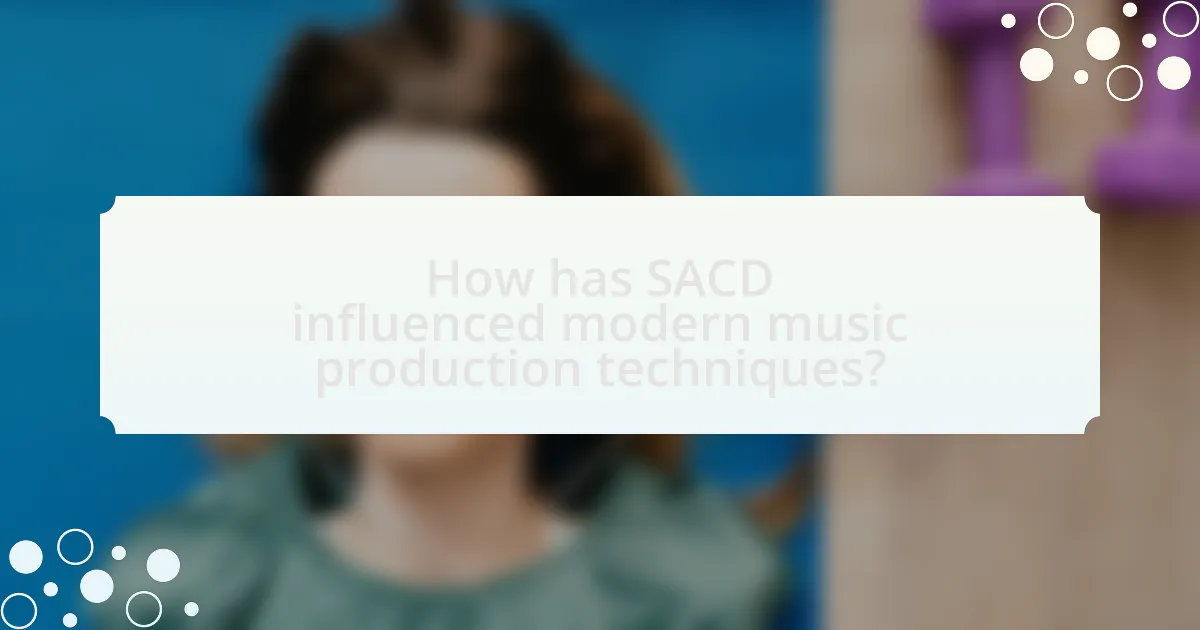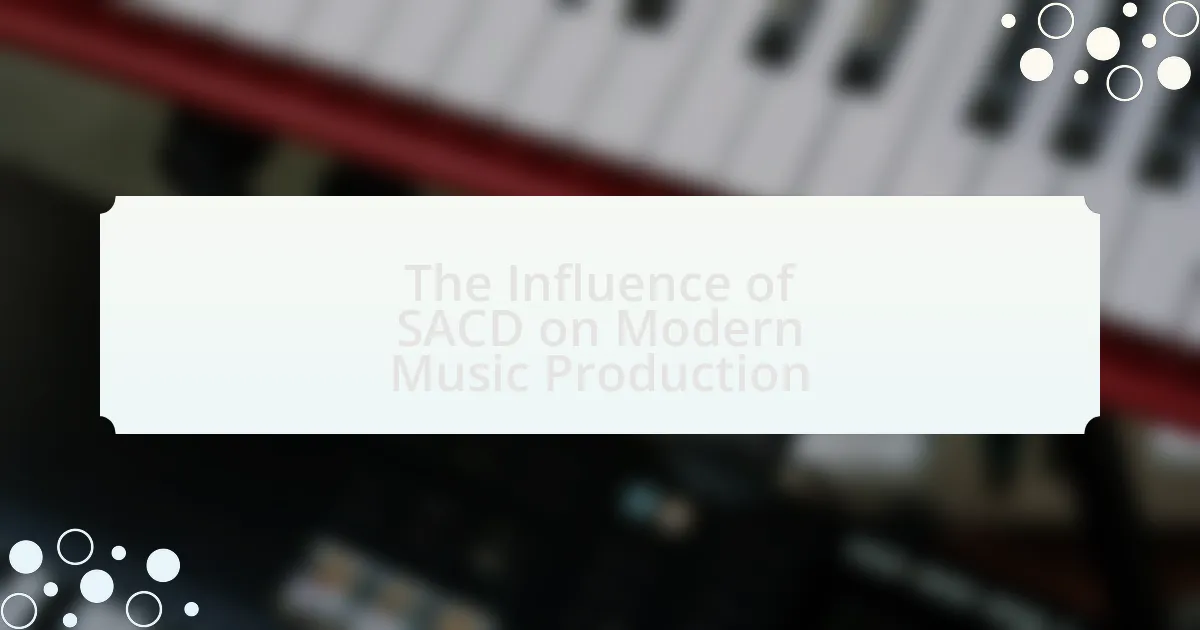SACD, or Super Audio CD, is a high-resolution audio format developed by Sony and Philips that significantly enhances sound quality in music production. This article explores the technical specifications of SACD, its differences from traditional audio formats, and its role in modern music production techniques. It discusses how SACD influences recording practices, the challenges producers face, and the evolving market trends surrounding this format. Additionally, the article examines the perceptions of artists and producers regarding SACD, as well as best practices for optimizing SACD projects in the studio environment.
What is SACD and its Role in Music Production?

SACD, or Super Audio CD, is a high-resolution audio format developed by Sony and Philips that enhances sound quality beyond standard CDs. Its role in music production is significant as it allows for multi-channel audio, providing a more immersive listening experience, and supports higher sampling rates and bit depths, which capture more detail in recordings. The introduction of SACD in 1999 aimed to meet the demand for superior audio fidelity, and its capability to deliver both stereo and surround sound has influenced the production techniques used by artists and producers, encouraging the use of advanced recording methods and equipment to fully utilize its potential.
How does SACD differ from traditional audio formats?
SACD, or Super Audio CD, differs from traditional audio formats primarily in its ability to deliver higher audio quality through a different encoding method. While traditional formats like CDs use PCM (Pulse Code Modulation) at a 16-bit/44.1 kHz resolution, SACD employs DSD (Direct Stream Digital) encoding, which operates at a 1-bit/2.8224 MHz rate. This allows SACD to capture a wider frequency range and dynamic range, resulting in a more detailed and immersive listening experience. Additionally, SACDs can support multi-channel audio, enhancing the spatial quality of sound, which is not typically available in standard CD formats.
What technical specifications define SACD?
SACD, or Super Audio CD, is defined by its use of Direct Stream Digital (DSD) encoding, which operates at a sampling rate of 2.8224 MHz, significantly higher than the standard CD’s 44.1 kHz. This high-resolution audio format supports multi-channel sound, allowing for up to six channels of audio, which enhances the listening experience by providing a more immersive soundstage. Additionally, SACD discs can contain both a DSD layer for high-resolution playback and a standard CD layer for compatibility with regular CD players, ensuring versatility in playback options. The specifications also include a capacity of up to 4.7 GB for single-layer discs and 8.5 GB for dual-layer discs, enabling the storage of high-quality audio content.
How does SACD enhance audio quality compared to CDs?
SACD enhances audio quality compared to CDs primarily through its higher resolution audio format. While CDs use a 16-bit depth and a sampling rate of 44.1 kHz, SACDs utilize a 1-bit DSD (Direct Stream Digital) format with a sampling rate of 2.8224 MHz, allowing for a broader dynamic range and more accurate sound reproduction. This increased resolution results in clearer highs, deeper lows, and a more immersive listening experience, as evidenced by the ability of SACD to capture nuances in music that standard CDs cannot.
Why was SACD developed and what needs does it address?
SACD, or Super Audio CD, was developed to provide a higher fidelity audio format that addresses the demand for superior sound quality in music reproduction. This format was introduced in 1999 by Sony and Philips to meet the needs of audiophiles and music enthusiasts who sought an enhanced listening experience beyond what standard CDs could offer. SACD utilizes a different encoding method called Direct Stream Digital (DSD), which allows for a wider dynamic range and greater detail in sound reproduction, thus fulfilling the need for high-resolution audio in both stereo and multi-channel formats.
What historical context led to the creation of SACD?
The creation of Super Audio CD (SACD) was influenced by the transition from analog to digital audio formats in the late 20th century. As digital audio technology advanced, particularly with the rise of the Compact Disc (CD) in the 1980s, there was a growing demand for higher fidelity sound and multi-channel audio experiences. This demand was driven by both consumer expectations for improved audio quality and the music industry’s desire to enhance the listening experience. The introduction of SACD in 1999 by Sony and Philips aimed to address these needs by offering higher resolution audio and the capability for surround sound, thus providing a more immersive listening experience compared to standard CDs.
How does SACD cater to audiophiles and music producers?
SACD caters to audiophiles and music producers by offering high-resolution audio quality that surpasses standard CD formats. This superior sound quality is achieved through its ability to store more audio data, utilizing Direct Stream Digital (DSD) technology, which provides a more accurate representation of the original recording. Audiophiles benefit from the enhanced dynamic range and clarity, while music producers appreciate the format’s capability to deliver a more immersive listening experience, allowing for finer details in the mix to be heard. The SACD format supports multi-channel audio, enabling producers to create surround sound experiences that are more engaging for listeners.
How has SACD influenced modern music production techniques?

SACD has significantly influenced modern music production techniques by introducing high-resolution audio formats that enhance sound quality and spatial imaging. This format, developed by Sony and Philips, allows for multi-channel audio, which has led to more immersive listening experiences in music production. The adoption of SACD has encouraged producers to explore advanced mixing techniques, utilizing surround sound and higher fidelity recordings, which have become standard in contemporary music production. Additionally, the emphasis on high-resolution audio has prompted the industry to prioritize better recording equipment and mastering processes, ultimately raising the overall quality of music releases.
What production techniques have evolved due to SACD?
The production techniques that have evolved due to SACD include high-resolution audio recording, multi-channel mixing, and advanced mastering processes. High-resolution audio recording allows for capturing sound at higher bit rates and sample rates, resulting in greater detail and clarity. Multi-channel mixing has become more prevalent, enabling producers to create immersive soundscapes by utilizing multiple audio channels, enhancing the listening experience. Advanced mastering processes have also emerged, focusing on optimizing audio for both stereo and multi-channel formats, ensuring that the final product maintains quality across different playback systems. These techniques reflect the influence of SACD on modern music production, emphasizing fidelity and listener engagement.
How do mixing and mastering processes change with SACD?
Mixing and mastering processes change with SACD by requiring higher resolution audio formats and different approaches to spatial audio. SACD, which supports DSD (Direct Stream Digital) encoding, necessitates mixing at a higher bit depth and sample rate, typically 1-bit/2.8224 MHz, compared to standard PCM formats. This higher resolution allows for greater dynamic range and detail, influencing how engineers balance levels and apply effects. Additionally, SACD’s capability for multi-channel audio encourages the use of surround sound techniques, altering the spatial placement of instruments and vocals in the mix. The need for compatibility with both stereo and multi-channel formats also impacts mastering decisions, ensuring that the final product sounds optimal across various playback systems.
What role does SACD play in the recording studio environment?
SACD, or Super Audio CD, plays a significant role in the recording studio environment by providing high-resolution audio quality that enhances the listening experience. This format supports multi-channel audio, allowing for immersive soundscapes that traditional CDs cannot achieve. The ability to deliver superior sound fidelity is crucial for producers and engineers aiming to create high-quality recordings that meet the demands of audiophiles. Additionally, SACD’s DSD (Direct Stream Digital) encoding method captures audio with greater detail and dynamic range, making it a preferred choice for classical and jazz recordings, where nuance is essential. This high-resolution capability has led to its adoption in studios focused on producing premium music content, thereby influencing modern music production standards.
How do artists and producers perceive the impact of SACD?
Artists and producers generally perceive the impact of SACD as a significant enhancement to audio quality and listening experience. They appreciate SACD’s ability to deliver high-resolution sound, which allows for greater detail and depth in music production. This perception is supported by the format’s use of Direct Stream Digital (DSD) technology, which captures audio with a higher sampling rate than standard CDs, resulting in a more accurate representation of the original recording. Additionally, many artists find that SACD’s multi-channel capabilities enable a more immersive listening experience, which can enhance the emotional impact of their music.
What are the opinions of contemporary artists on SACD usage?
Contemporary artists generally view SACD (Super Audio CD) usage positively, appreciating its high-resolution audio quality. Many artists believe that SACD enhances the listening experience, allowing for greater detail and depth in music production. For instance, artists like Steven Wilson have advocated for SACD, citing its ability to deliver superior sound fidelity compared to traditional formats. Additionally, the multi-channel capabilities of SACD are seen as beneficial for immersive audio experiences, which some contemporary musicians actively seek to create in their work.
How do producers incorporate SACD in their workflow?
Producers incorporate SACD (Super Audio CD) in their workflow by utilizing its high-resolution audio capabilities to enhance sound quality in music production. This format allows producers to work with multi-channel audio, providing a more immersive listening experience. By integrating SACD into their workflow, producers can take advantage of its superior sampling rates and bit depth, which result in clearer and more detailed sound reproduction compared to standard CDs. Additionally, SACD’s ability to support both stereo and surround sound formats enables producers to create richer soundscapes, appealing to audiophiles and enhancing the overall production value of their music.
What are the challenges and limitations of using SACD in music production?

The challenges and limitations of using SACD in music production include high production costs, limited consumer adoption, and compatibility issues with existing playback systems. High production costs arise from the need for specialized equipment and mastering techniques, which can deter smaller studios from utilizing SACD. Limited consumer adoption is evident as many listeners still prefer standard CD formats or digital downloads, resulting in a smaller market for SACD releases. Compatibility issues occur because not all audio equipment supports SACD playback, which can restrict the audience for SACD recordings. These factors collectively hinder the widespread use of SACD in the music production industry.
What technical challenges do producers face with SACD?
Producers face several technical challenges with Super Audio CD (SACD), primarily related to its complex format and production requirements. The SACD format utilizes Direct Stream Digital (DSD) encoding, which demands high-quality analog-to-digital converters and specialized mastering equipment, making the production process more intricate compared to standard CDs. Additionally, the dual-layer structure of SACDs, which includes both a high-resolution layer and a standard CD layer, complicates the mastering process and requires careful attention to ensure compatibility across different playback systems. Furthermore, the limited market penetration of SACD players poses a challenge for producers, as they must balance the investment in SACD production with the potential audience reach. These factors collectively contribute to the technical difficulties producers encounter when working with SACD.
How does the complexity of SACD affect production timelines?
The complexity of SACD (Super Audio CD) significantly extends production timelines due to its advanced audio formats and multi-channel capabilities. Producing SACD requires specialized mastering techniques and equipment to handle high-resolution audio and DSD (Direct Stream Digital) encoding, which are more intricate than standard CD production processes. This complexity necessitates additional time for sound engineers to ensure optimal audio quality and compatibility across different playback systems, often resulting in longer project durations compared to traditional formats.
What are the compatibility issues with SACD in modern setups?
SACD, or Super Audio CD, faces several compatibility issues in modern setups primarily due to the limited availability of SACD players and the format’s unique encoding. Many contemporary audio systems do not support SACD playback, as they are designed primarily for standard CD formats or digital streaming. Additionally, SACD’s multi-channel audio capabilities require specific hardware to fully utilize, which is often absent in standard home audio systems.
The lack of widespread adoption of SACD technology has resulted in fewer manufacturers producing compatible devices, leading to a fragmented market. According to a report by the Consumer Technology Association, as of 2021, only a small percentage of audio equipment sold supports SACD, highlighting the challenges users face in integrating this format into their modern audio setups.
What market trends are emerging around SACD in music production?
Emerging market trends around SACD in music production include a resurgence in high-resolution audio formats and a growing consumer preference for immersive sound experiences. The increasing availability of SACD players and titles, alongside the rise of streaming services offering high-fidelity audio, indicates a shift towards premium audio quality. According to a report by the International Federation of the Phonographic Industry, sales of high-resolution audio formats, including SACD, have seen a steady increase, reflecting consumer demand for superior sound. Additionally, collaborations between artists and labels to produce SACD releases are becoming more common, further solidifying SACD’s role in modern music production.
How is the demand for SACD changing in the industry?
The demand for SACD (Super Audio CD) is experiencing a gradual decline in the industry. This trend is primarily due to the increasing popularity of digital streaming services, which offer convenience and accessibility that physical formats cannot match. According to a report by the Recording Industry Association of America, physical media sales, including SACDs, have been decreasing consistently, with a significant shift towards digital consumption over the past decade. Additionally, the limited catalog of SACD releases compared to mainstream digital formats further contributes to its reduced demand.
What future developments can be expected for SACD technology?
Future developments for SACD technology are likely to include enhanced audio formats and improved compatibility with streaming services. As consumer demand for high-resolution audio increases, manufacturers may focus on integrating SACD players with digital streaming capabilities, allowing users to access high-quality audio content seamlessly. Additionally, advancements in digital signal processing and storage technology could lead to the development of new SACD formats that offer even higher fidelity and more immersive listening experiences. The ongoing interest in surround sound formats, such as Dolby Atmos, may also influence SACD technology, potentially leading to hybrid formats that combine SACD’s high-resolution audio with advanced surround sound capabilities.
What best practices should producers follow when working with SACD?
Producers should prioritize high-resolution audio formats and proper mastering techniques when working with SACD. Utilizing DSD (Direct Stream Digital) for recording ensures superior sound quality, as SACD is designed to handle high-frequency audio that standard CDs cannot. Additionally, producers should maintain a clean signal path and use high-quality microphones and preamps to capture the best sound possible. It is also essential to understand the limitations of SACD, such as its compatibility with standard CD players, which can affect distribution. Following these practices enhances the overall listening experience and maximizes the potential of SACD in modern music production.
How can producers optimize their workflow for SACD projects?
Producers can optimize their workflow for SACD projects by implementing a streamlined production process that emphasizes high-resolution audio formats and efficient collaboration tools. Utilizing digital audio workstations (DAWs) that support SACD specifications allows for better management of multi-channel audio tracks, which is essential for SACD’s surround sound capabilities. Additionally, adopting cloud-based collaboration platforms facilitates real-time feedback and file sharing among team members, reducing delays in the production timeline.
Research indicates that projects utilizing high-resolution audio formats, such as SACD, can benefit from improved sound quality and listener engagement, which reinforces the importance of optimizing workflows to fully leverage these advantages.
What common mistakes should be avoided in SACD production?
Common mistakes to avoid in SACD production include neglecting proper mastering techniques, failing to utilize the full dynamic range, and not considering the playback environment. Proper mastering is crucial because SACD’s high-resolution audio capabilities require careful attention to detail to ensure optimal sound quality. Utilizing the full dynamic range is essential, as SACD can reproduce subtle nuances that standard formats cannot; overlooking this can lead to a flat listening experience. Additionally, the playback environment should be taken into account, as poor acoustics can diminish the benefits of SACD’s superior audio fidelity.

Leave a Reply